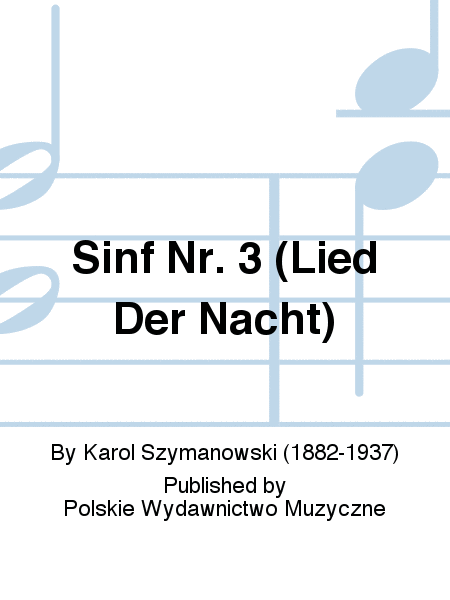Symphony No. 3 The Song of the Night Op. 27$47.95 - See more - Buy online Lead time before shipment : 4 to 6 weeks Format : Score Solo Vocal, Mixed Choir and Orchestra SKU: BT.PWM5363020 For Tenor Solo, Mixed Choir, Organ and Orchestra. Composed by Karol Szymanowski. Classical. Score Only. Composed 1985. 92 pages. Polskie Wydawnictwo Muzyczne #PWM5363020. Published by Polskie Wydawnictwo Muzyczne (BT.PWM5363020).The Third Symphony occupies an special place in the evolutionary process of Szymanowskis style. The Symphony The Song of the Night, Op. 27, is a setting of the poem of the same title, from the second divan of Mawlana Jalal-ad-din Rumi, for tenor solo, mixed choir and orchestra. It was completed in the summer 1916. Szymanowskis interest in oriental music at this period is not so much , as far as the Third Symphony is concerned, an attempt at some formal stylisation of eastern music, but rather an indication of his search for some mode of expression which would best reflect the conflicts of his aesthetic and artistic ideas. It was the direct contact made with the art of the Grecian and Arabic worlds during his travel to Sicily and North Africa in 1911 and 1914 that provided the external stimulus for this interest. The Third Symphony can be classed with those symphonies for chorus and solo voices so often favoured by the neo-romantic and expressionist composers. It is written in a free ternary form, the thematic material being the basic unifying structural element, which imparts a conciseness to the form, and retaining the function despite the significant changes that occur in the melodic character of the music. The texture is polymelodic, and a score reveals a masterly interweaving of the multiplicity of parts, melodic lines and patterns of sound. This symphony is consummation of all Szymanowskis mastery in instrumentation and colour, and a superb study of orchestral polyphony. Here, Szymanowski liberates himself from the rigid relations of the functional harmonic system. In the place of tonal progressions, he shifts chromatically from one sound lane to another, of which the smallest units are chords made up of tritones and seconds, using only a free intervallic structure, far more remote in Szymanowski from the dominant centralistic harmony then Debussy. In style, the Third Symphony belongs to the neo-romantic period, if this can be broadly defined as including modernistic and expressionistic trends, and to musical impressionism. (based on the Preface to the ''Works'' by Teresa Chyli ska, PWM 1985). Publisher : PWM (Polskie Wydawnictwo Muzyczne)
|








